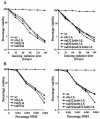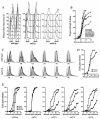The fission yeast Rad32 (Mre11)-Rad50-Nbs1 complex is required for the S-phase DNA damage checkpoint
- PMID: 12944482
- PMCID: PMC193710
- DOI: 10.1128/MCB.23.18.6564-6573.2003
The fission yeast Rad32 (Mre11)-Rad50-Nbs1 complex is required for the S-phase DNA damage checkpoint
Abstract
Mre11, Rad50, and Nbs1 form a conserved heterotrimeric complex that is involved in recombination and DNA damage checkpoints. Mutations in this complex disrupt the S-phase DNA damage checkpoint, the checkpoint which slows replication in response to DNA damage, and cause chromosome instability and cancer in humans. However, how these proteins function and specifically where they act in the checkpoint signaling pathway remain crucial questions. We identified fission yeast Nbs1 by using a comparative genomic approach and showed that the genes for human Nbs1 and fission yeast Nbs1 and that for their budding yeast counterpart, Xrs2, are members of an evolutionarily related but rapidly diverging gene family. Fission yeast Nbs1, Rad32 (the homolog of Mre11), and Rad50 are involved in DNA damage repair, telomere regulation, and the S-phase DNA damage checkpoint. However, they are not required for G(2) DNA damage checkpoint. Our results suggest that a complex of Rad32, Rad50, and Nbs1 acts specifically in the S-phase branch of the DNA damage checkpoint and is not involved in general DNA damage recognition or signaling.
Figures





Similar articles
-
Molecular characterization of the Schizosaccharomyces pombe nbs1+ gene involved in DNA repair and telomere maintenance.Mol Cell Biol. 2003 Sep;23(18):6553-63. doi: 10.1128/MCB.23.18.6553-6563.2003. Mol Cell Biol. 2003. PMID: 12944481 Free PMC article.
-
The fission yeast Rad32(Mre11)-Rad50-Nbs1 complex acts both upstream and downstream of checkpoint signaling in the S-phase DNA damage checkpoint.Genetics. 2010 Apr;184(4):887-97. doi: 10.1534/genetics.109.113019. Epub 2010 Jan 11. Genetics. 2010. PMID: 20065069 Free PMC article.
-
The Aspergillus nidulans sldI(RAD50) gene interacts with bimE(APC1), a homologue of an anaphase-promoting complex subunit.Mol Microbiol. 2005 Jul;57(1):222-37. doi: 10.1111/j.1365-2958.2005.04671.x. Mol Microbiol. 2005. PMID: 15948962
-
Rad50S alleles of the Mre11 complex: questions answered and questions raised.Exp Cell Res. 2006 Aug 15;312(14):2694-9. doi: 10.1016/j.yexcr.2006.06.013. Epub 2006 Jun 20. Exp Cell Res. 2006. PMID: 16857186 Review.
-
A curious new role for MRN in Schizosaccharomyces pombe non-homologous end-joining.Curr Genet. 2018 Apr;64(2):359-364. doi: 10.1007/s00294-017-0760-1. Epub 2017 Oct 10. Curr Genet. 2018. PMID: 29018935 Free PMC article. Review.
Cited by
-
Release of Ku and MRN from DNA ends by Mre11 nuclease activity and Ctp1 is required for homologous recombination repair of double-strand breaks.PLoS Genet. 2011 Sep;7(9):e1002271. doi: 10.1371/journal.pgen.1002271. Epub 2011 Sep 8. PLoS Genet. 2011. PMID: 21931565 Free PMC article.
-
Checkpoint-dependent regulation of origin firing and replication fork movement in response to DNA damage in fission yeast.Mol Cell Biol. 2009 Jan;29(2):602-11. doi: 10.1128/MCB.01319-08. Epub 2008 Nov 10. Mol Cell Biol. 2009. PMID: 19001087 Free PMC article.
-
Histone H2A phosphorylation controls Crb2 recruitment at DNA breaks, maintains checkpoint arrest, and influences DNA repair in fission yeast.Mol Cell Biol. 2004 Jul;24(14):6215-30. doi: 10.1128/MCB.24.14.6215-6230.2004. Mol Cell Biol. 2004. PMID: 15226425 Free PMC article.
-
Mre11 and Ku regulation of double-strand break repair by gene conversion and break-induced replication.DNA Repair (Amst). 2007 Jun 1;6(6):797-808. doi: 10.1016/j.dnarep.2007.01.006. Epub 2007 Feb 26. DNA Repair (Amst). 2007. PMID: 17321803 Free PMC article.
-
Roles of the checkpoint sensor clamp Rad9-Rad1-Hus1 (911)-complex and the clamp loaders Rad17-RFC and Ctf18-RFC in Schizosaccharomyces pombe telomere maintenance.Cell Cycle. 2010 Jun 1;9(11):2237-48. doi: 10.4161/cc.9.11.11920. Epub 2010 Jun 1. Cell Cycle. 2010. PMID: 20505337 Free PMC article.
References
-
- Bähler, J., J. Q. Wu, M. S. Longtine, N. G. Shah, A. McKenzie III, A. B. Steever, A. Wach, P. Philippsen, and J. R. Pringle. 1998. Heterologous modules for efficient and versatile PCR-based gene targeting in Schizosaccharomyces pombe. Yeast 14:943-951. - PubMed
-
- Boddy, M. N., B. Furnari, O. Mondesert, and P. Russell. 1998. Replication checkpoint enforced by kinases Cds1 and Chk1. Science 280:909-912. - PubMed
Publication types
MeSH terms
Substances
LinkOut - more resources
Full Text Sources
Molecular Biology Databases
Research Materials
Miscellaneous
